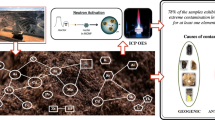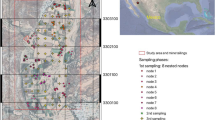Abstract
Gold has been mined on a large scale at Yellowknife located in the sub-arctic North West Territories of Canada since 1938. The gold is associated with arsenopyrite ores, with necessitates the oxidation of the arsenic and sulphur by roasting at two Yellowknife smelters. Other metals are also present in the ore, notably antimony. As2O3 and SO2 are emitted into the atmosphere. Large quantities of arsenic were liberated in the past and despite improvements in emission control, significant emission still occur. In order to assess the amount and extent of arsenic contamination in the local environment and the potential exposures and sources to man, soil samples and samples of the native vegetation were collected in and around the town of Yellowknife and the two smelters. Arsenic and antimony analyses were done by instrumental neutron activation analysis using the SLOWPOKE facility at University of toronto. Air-dried plant samples were bombarded at a neutron flux of 1·1012n cm2s and soil samples at 2.5·1011n cm2s for 6 minute periods. The122Sb and76As-ray emissions at 559 keV were analysed after decay periods of 24–48 hours and compared with standard solutions and NBS standards. Zinc, copper, lead and cadmium analyses were done by atomic absorption spectrophotometry.
Arsenic was found to be accumulated in the soils in the vicinity of the two smelters to levels of several thousand ppm. Concentrations greater than 500 ppm occurred in the soil of Yellowknife townsite, and greater than 50 ppm occurred at all sites sampled within 15 km of the town. Antimony levels were about 10% of arsenic and were highly correlated with arsenic. Zinc occurred to 500 ppm around the smelters.
Compared with background levels, the foliage of several native species showed substantial arsenic accumulation, up to several hundred ppm in birch. Only 5–25% of this arsenic could be removed by careful washing. Evidence suggests the arsenic is taken up from the soil creating an ongoing arsenic contamination problem. Soil arsenic levels are also sufficiently high to inhibit root growth in soils over a very extensive area.
Similar content being viewed by others
References
B. ANASTASIA, J. KENDER, (1973). J. Environ. Qual., 2, 335.
H. J. M. BOWEN, (1966). Trace Elements in Biochemistry. Academic Press, London.
Canadian Public Health Association (1977). Task Force on Arsenic (Yellowknife, North West Territories Canada). Final Report. Dec. 1977.
M. R. FALK, M. D. MILLER, S. J. M. KOSTIUK (1974). Biological effects of mining wastes in the N.W.T. Technical Report Series no. CEN/T-73-10. Dept. of the Environment, Fisheries and Marine Service, Fisheries Operations Directorate, Central Region.
R. W. R. GRIMMETT, (1939). New Zealand J. Agric., 58, 383.
D. HOCKING, P. KUCHAR, J. A. PLAMBECK, R. A. SMITH, (1978) J. Air Pollution Control Assoc., 28, 2, 133.
R. E. JERVIS, B. TIEFENBACH, (1978). In Intern. Symp. Nuclear Activation Techniques. IAEA-SM-227/67, Vienna.
P. J. LANDRIGAN, S. H. GEHLBACK, B. F. ROSENBLUM, J. M. SHOULTS, R. M. CANDELARIA, W. M. BARTHEL, J. A. LIDDLE, R. L. SMREK, N. W. STAEHLING, J. F. SAUNDERS, (1975). New England J. Med., 292, 123.
J. J. O'TOOLE, R. G. CLARK, K. L. MALABY, D. L. TRAUGER, (1972). In Nuclear Methods in Environmental Research. Univ. Missouri Press, Columbia MO. (1972) 172–185.
J. J. PACIGA, (1975). PhD. Thesis. Dept. Chem. Eng. and Applied Chemistry. University of Toronto Canada.
T. M. ROBERTS, T. C. HUTCHINSON, J. PACIGA, A. CHATTOPADHYAY, R. E. JERVIS, J. VAN LOON, D. K. PARKINSON, (1974) Science, 186, 1120.
T. M. ROBERTS, W. GIZYN, T. C. HUTCHINSON, (1974a). In Trace Substances in Environmental Health. A Symp. D. D. HEMPHILL (Ed.), Univ. Missouri, Columbia. Vol, 8, p. 155.
R. A. SMITH, (1977). Science of the Total Environment 7, 227.
R. WAGEMANN, N. B. SNOW, D. M. ROSENBERG, A. LUTZ, (1978). Arch. Environm. Contam. Toxicol., 7, 169.
Author information
Authors and Affiliations
Rights and permissions
About this article
Cite this article
Hutchinson, T.C., Aufreiter, S. & Hancock, R.G.V. Arsenic pollution in the Yellowknife Area from gold smelter activities. J. Radioanal. Chem. 71, 59–73 (1982). https://doi.org/10.1007/BF02516141
Received:
Issue Date:
DOI: https://doi.org/10.1007/BF02516141




